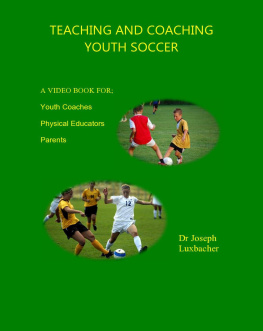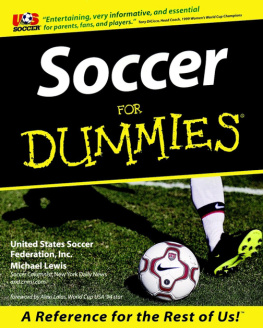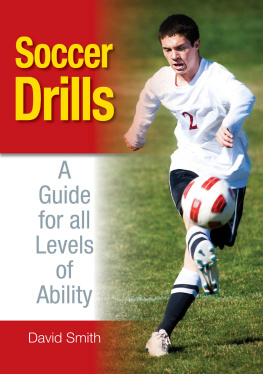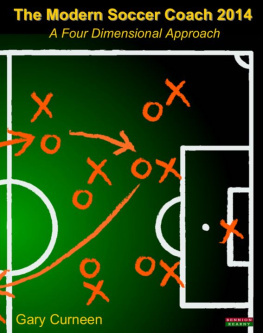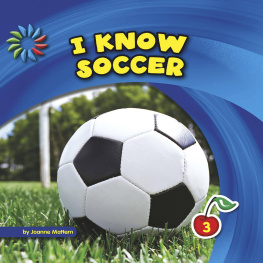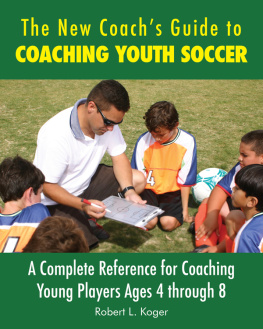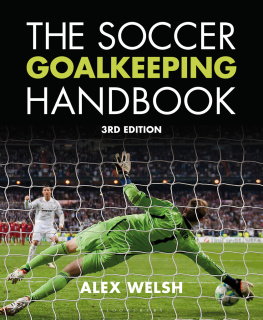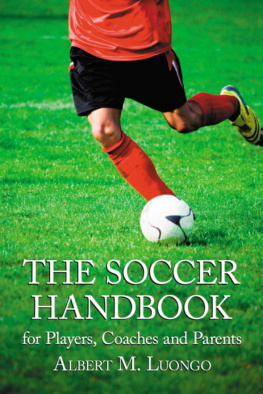Coaching Soccer
The Fundamentals

T able of Contents
Coaching Soccer
Joseph A. Luxbacher, PhD
Preface
CHAPTER 1
The Game of Soccer
HISTORY
SOCCER IN THE USA
CHAPTER 2
Tools of the Trade
SHOES
SOCCER BALL
UNIFORMS
GOALKEEPER EQUIPMENT
COACHING AIDS
CONES
SCRIMMAGE VESTS
PORTABLE FULL-SIZE GOALS
MINI-GOALS
PENDULUM BALL
AUDIO VISUAL EQUIPMENT
CHAPTER 3
FOUNDATIONS OF COACHING
Fitness
Flexibility
Points to consider
Agility & Mobility
Endurance
Speed
Muscular Strength and Power
Skills
* Foundation Stage
* Game-Related Stage
* Game-Condition Stage
Tactics
* Individual Tactics
* Group Tactics
Summary Points
CHAPTER 4
TEAM MANAGEMENT
CREATE A POSITIVE LEARNING ENVIRONMENT
CONSIDER THE PLAYERS SOCCER AGE
NO LINES, NO LECTURES
The more times a player can pass, receive, shoot, and dribble the ball the more likely he or she will enjoy the practice and improve skill performance. Conversely, standing in long lines while waiting for an infrequent opportunity to pass or shoot the ball doesnt make for a good practice. It is important that an ample supply of balls, ideally one for each player, is available. The easiest way to guarantee a sufficient number of balls is to require each player to bring a ball to practice. Just as baseball players bring their glove to the field, soccer players should bring a ball. An ample supply of balls provides you with many more options for drills and training games
KEEP THE SESSION SIMPLE
Much of soccer's inherent beauty rests with the fact that it is basically a simple game. Keep it that way! Complicated drills or highly intricate training exercises will serve only to confuse and frustrate, rather than motivate, players. When planning practices always take into consideration the "K.I.S.S." principle of coaching KEEP IT SIMPLE STUPID! This principle applies to coaching all ages and ability levels
DEVELOP A THEME
TEACH IN A PROGRESSION
Planning an effective practice requires more thought than simply selecting several unrelated exercises and haphazardly inserting them into a training session. Each drill or exercise should lay the groundwork for those that follow. Introduce the session with fundamental activities and gradually progress to more match-like situations. For example, the practice could begin with simple passing drills involving minimal player movement and gradually progress to situations where players must pass and receive the ball while moving at game speed under the pressure of challenging opponents. Where to start in the progression depends upon the ability and experience of the players. Higher-level players will naturally begin with more demanding exercises than novice players. In both cases, however, organize the sequence of drills so that each exercise serves as a natural lead-in for the next. Each should relate to the central theme of the practice session.
KEEP PRACTICE PLAYER CENTERED
SAFE PRACTICE ENVIRONMENT
Soccer is a contact sport and as such involves a certain amount of physical risk. Accidental collisions, bumps, and bruises will sometimes occur. To minimize the likelihood of injury make every effort to provide players with a safe practice and playing environment. This includes adequate supervision, sound planning, and appropriate matching of players with others of similar size and ability.
ECONOMICAL TRAINING METHODS
END WITH A GAME
EVALUATE THE SESSION
SAMPLE PRACTICE FORMAT
PRACTICE THEME
Fitness Training (10 minutes
PRE-PRACTICE CHECKLIST
SOCCER SAFETY
RISK MANAGEMENT: AVOIDING PITFALLS
CHAPTER 5
PASSING and RECEIVING SKILLS
GROUND PASSES
INSIDE-OF-THE-FOOT PASS
ERROR:
ERROR
SOLUTION:
OUTSIDE OF THE FOOT PASS
INSTEP PASS
LOFTED PASSES
SHORT CHIP PASS
LOFTED INSTEP PASS
SUMMARY POINTS
TRAINING EXERCISES
RECEIVING GROUND BALLS
INSIDE-OF-THE-FOOT TECHNIQUE
OUTSIDE-OF-THE-FOOT TECHNIQUE
ERROR: The ball bounces out of range of control.
RECEIVING LOFTED BALLS
RECEIVING ON INSTEP
RECEIVING ON THIGH
RECEIVING ON CHEST
Controlling a ball with the chest
RECEIVING WITH THE HEAD
SUMMARY POINTS
TRAINING EXERCISES
CHAPTER 6
DRIBBLING SKILLS
DRIBBLING SKILLS
Dribble for Close Control
Dribble for Speed
SHIELDING THE BALL
SUMMARY POINTS
Training Exercises
CHAPTER 7
TACKLING SKILLS
Table of Contents
Joseph A. Luxbacher, PhD
Preface
Soccer! The mere word evokes an outpouring of passion and emotion unequaled within the realm of competitive sport. Known as "football" throughout most of the world, soccer is the major sport of nearly every country in Asia, Africa, Europe, and South America. According to FIFA (Fdration Internationale de Football Association), the international governing body of soccer, there are approximately 265 million male and female players in addition to 5 million referees and officials that make a grand total of 270 million people, or 4% of the world's population who are actively involved in the game of international football. Soccer remains the only football-type game played at the Olympics and millions more people follow the mens World Cup, soccer's international championship, than the NFL Super Bowl and Baseball World Series. The 2014 FIFA World Cup broke several TV audience records in key international markets, including the United States and Germany. The final between Argentina and eventual champions Germany attracted an in-home audience of 695 million viewers. The total audience for the final, including in-home and out-of-home figures for viewers, hit 1.013 billion. As I write this page the 2018 World Cup has just ended with France securing the title, and I assume viewership of the tournament was of a similar magnitude. Soccer is without question the world's most popular game.
CHAPTER 1
The Game of Soccer
A soccer match is played between two teams comprised of eleven players each on a field area that is longer and wider than the traditional American football field. A regulation game consists of two 45-minute periods. One player on each team is designated as a goalkeeper and assigned the responsibility of protecting the team's goal. The goalkeeper is the only player permitted use of the hands to control the ball and can do so only within the team's penalty area. Field players must control the ball with feet, legs, body, or head, but not the hands or arms. The objective for each team is to score more goals than opponents. Goals are scored by kicking or heading the ball over the goal line into the opponent's goal. Each goal scored counts one point.
HISTORY
Historical accounts indicate that soccer-type kickball games have their origins in ancient times. An early forerunner of soccer called "tsu chu" was played in China as early as 2000 B.C. Tsu chu involved kicking a stuffed ball made of animal skin and was usually played during festivals and holiday celebrations. Kickball-type games evolved in other areas of the ancient world as well. The Greek's played "episkyres" as early as 600 B.C. At about the same time the Romans were playing a similar game called "harpustum". Matches were played between rival villages with the town squares designated as goals. The ball was the inflated bladder of a cow or goat, and the games often lasted several days. Both episkyres and harpustum contained elements of soccer and rugby. They were ball-carrying games that lacked uniform rules of play, and only vaguely resembled soccer as we know it today.
Next page
